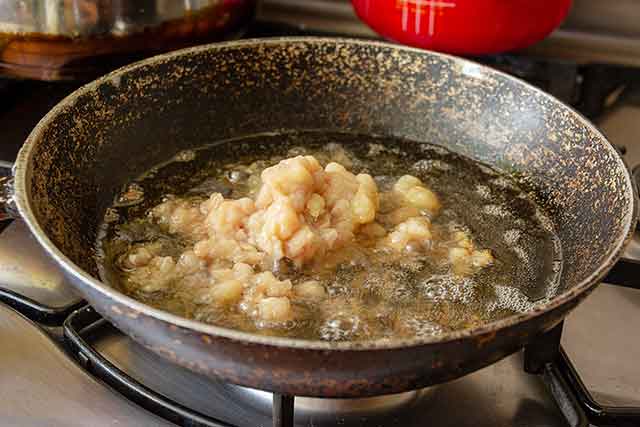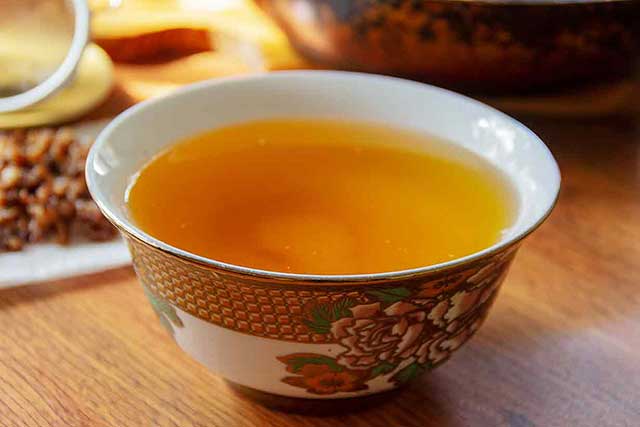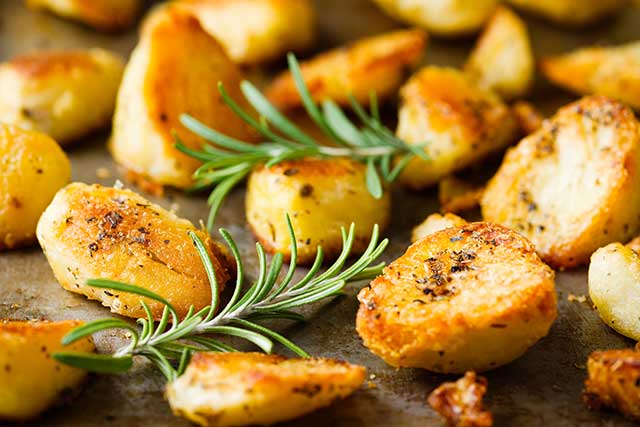Goose fat is arguably the best-tasting cooking fat in the world.
Renowned for its delicious flavor, goose fat has an interesting nutrition profile too.
But is it a healthy choice?
In this article, we examine the nutrition and health properties of goose fat and some tasty ways to use it.
What Is Goose Fat?
Firstly, goose fat refers to fat rendered from a goose.
Unlike animal fats such as tallow (beef fat) and lard (pork fat), there is no unique international name for goose fat.
However, it merely goes by the name of “schmaltz” in Germany.
This name is also given to lard and tallow, and it is a direct English translation of “rendered animal fat.”
Appearance
Goose fat has a cream to yellow color which may depend somewhat on the diet of the geese.
At hot temperatures, goose fat has a liquid consistency, but it is semi-solid at room temperature, and it has a thick and “creamy” look.
The room temperature consistency of goose fat looks something like slightly warm coconut oil, but with a more yellow shade of color.
In this state, goose fat is soft and spreadable like slightly warm butter.
Taste
Goose fat has a rich and flavorful taste, and when used as a cooking fat, it imparts a deep flavor to food.
However, the taste (and smell) is slightly milder and not as strong-tasting as pork fat (lard).
Goose fat is highly valued for its distinct taste in recipes, and particularly so in Europe.
While the fat features in many popular dishes, goose-fat roasted potatoes is one of the most traditional (and famous) ways to use it.
Basic Facts
- Melting point: goose fat has a melting point between 25°C and 37°C (or 77°F-99°F) (1).
- Smoke point: goose fat fares quite well at high temperatures, and it has a smoke point of 190°C (or 375°F) (2).
- Shelf-life: after opening, goose fat will stay fresh when refrigerated for up to three months (3).
Nutrition Facts
The following tables show the full nutrition profile of goose fat per tablespoon serving and per 100 grams.
All nutrition data comes from the USDA Food Composition Databases (4).
| Calorie/Nutrient | Amount per tbsp | Amount per 100g |
|---|---|---|
| Calories | 115 kcal | 900 kcal |
| Carbohydrate | 0.0 g | 0.0 g |
| Fiber | 0.0 g | 0.0 g |
| Sugars | 0.0 g | 0.0 g |
| Fat | 12.7 g | 99.8 g |
| Saturated Fat | 3.5 g | 27.7 g |
| Monounsaturated Fat | 7.2 g | 56.7 g |
| Polyunsaturated Fat | 1.4 g | 11.0 g |
| Omega-3 | 63.8 mg | 500 mg |
| Omega-6 | 1250 mg | 9801 mg |
| Protein | 0.0 g | 0.0 g |
As shown, goose fat is an isolated source of dietary fat and contains no carbohydrates or protein.
The fat content is primarily monounsaturated fat, with smaller proportions of saturated and polyunsaturated fatty acids.
Fatty Acid Profile
For those who are interested in a full breakdown of the fatty acid profile, you can find the fatty acids in goose fat below.
| Type of Fat | Amount per 100g |
|---|---|
| Saturated Fatty Acids | 27.7 g |
| Palmitic acid | 20.7 g |
| Stearic acid | 6.1 g |
| Myristic acid | 0.5 g |
| Monounsaturated Fatty Acids | 56.7 g |
| Oleic acid | 53.5 g |
| Palmitoleic acid | 2.8 g |
| Paullinic acid | 0.1 g |
| Polyunsaturated Fatty Acids | 11.0 g |
| Linoleic acid | 9.8 g |
| Linolenic acid | 0.5 g |
Benefits of Using Goose Fat

Here is a summary of the benefits that goose fat offers.
1) Goose Fat Is Fairly Heat Stable
By total ratio, goose fat contains;
- Saturated fat: 29.0%
- Monounsaturated fat: 59.5%
- Polyunsaturated fat: 11.5%
Saturated fats are the most heat-stable types of fatty acids, and monounsaturated fats are reasonably resistant to oxidation too. Polyunsaturated fat can be more prone to oxidation at high heat temperatures, but goose fat only contains minimal amounts of these fats (5, 6).
Overall, the fatty acid ratio of goose fat is somewhat similar to olive oil, which is widely considered to be one of the best cooking fats (7, 8).
That said, extra virgin olive oil also contains a range of polyphenols that provide additional protection against oxidative damage (9).
Unfortunately, there doesn’t appear to be any scientific research that directly tests the oxidative stability of goose fat.
However, based on the fatty acid ratio and smoke point, goose fat should stand up to high temperatures fairly well.
2) High In Oleic Acid
As shown in the prior fatty acid breakdown, goose fat is more than 50% composed of just one fatty acid called oleic acid.
Oleic acid is a monounsaturated fatty acid that the media often call a “heart healthy” fat, and it is also the predominant fatty acid in avocados and olives (10).
There is also a wide range of research on the potential benefits of oleic acid.
For instance, epidemiological and mechanistic research shows that the fatty acid may have anti-inflammatory and immune-enhancing properties (11, 12, 13).
Animal studies also show that oleic acid may help to reduce inflammation (14, 15).
3) Goose Fat Contains Vitamin E
In addition to its fatty acids, goose fat also contains a small amount of vitamin E.
Per 100 grams, goose fat provides 2.70 mg of vitamin E, which is 0.35 mg per tablespoon serving (4).
However, it is worth noting that these are relatively insignificant amounts.
For instance, the reference daily intake for vitamin E is 15 mg for adults, so a typical serving of goose fat would only offer around 2% of the RDI (16).
Vitamin E helps to protect fats from oxidation, and it may also strengthen our immune system (17, 18).
4) The Taste
Rather than having any extraordinary health properties, the best benefit of using goose fat is simply the delicious taste.
Goose fat makes literally anything you use it with taste better, and it enhances both the texture and flavor of food.
5) Pasture Raised
Although this isn’t always the case, geese are often raised outdoors and have access to fresh pasture.
This fact is because the birds enjoy foraging to find their food, which also cuts down on the farmer’s production expenses (19).
As a result, goose products tend to be from animals treated well.
However, some goose fat products do come from geese raised primarily for foie gras – which some people may wish to avoid.
In this case, individual goose fat products for sale should be traceable (from their packaging) back to the farm from where they were produced.
How To Render Goose Fat?
The production of goose fat is straightforward and involves minimal processing.
Typically goose fat is drained off roasted goose meat, or it can be trimmed from whole geese and then rendered (20).
If you have some goose meat, then it is also easy to render your own goose fat at home. There is a simple guide on how to do that here.
Recipes
For those that enjoy potatoes, the most popular goose fat recipe is probably goose fat-roasted potatoes. You can see a good recipe for these here.
There is also a wide range of different ways in which you can use goose fat in cooking.
For more tasty ideas, there are 15 recipes available here – including crispy lamb belly and beef bourguignon.
Where To Buy Goose Fat
Goose fat can be harder to find in the United States, but some stores do sell it. An online search of local stockists may bring up a good source.
Alternatively, it is available to buy online.
Goose fat should be widely available in the United Kingdom and Europe across independent stores and supermarkets.
Availability in other countries will vary.
Final Thoughts
Overall, goose fat is a heat-stable cooking fat that has a reasonably good nutrition profile.
That said, it is far from a necessity in the diet, it doesn’t have any unique benefits, and it can also be reasonably expensive compared to other animal fats.
However, people are right when they claim that goose fat is possibly the tastiest cooking fat. Goose fat offers so much extra in the taste department than typical cooking oils.
For this reason, it is worth trying at least once.
To learn more about cooking fats, see this guide to 25 common cooking fats.


